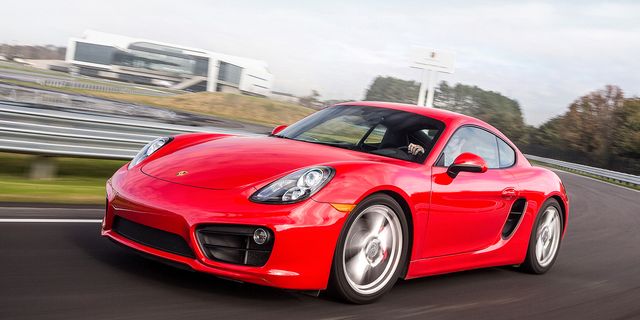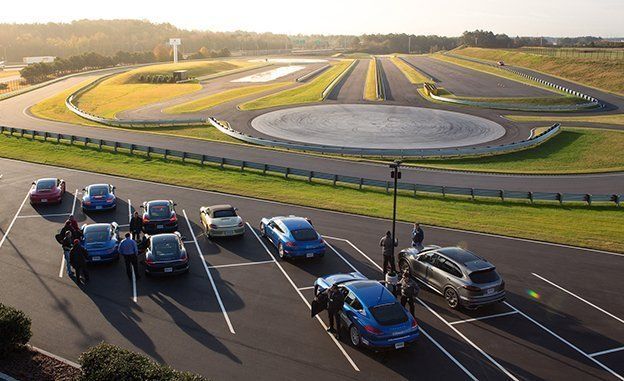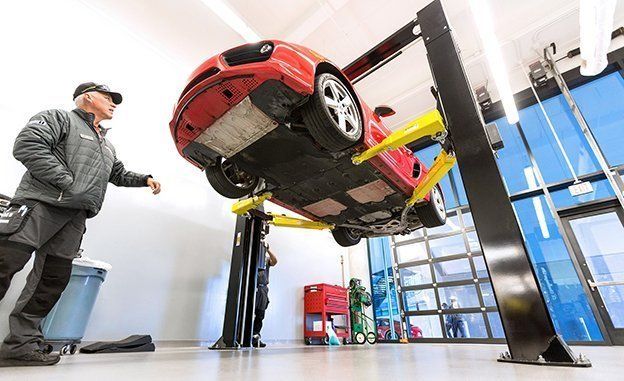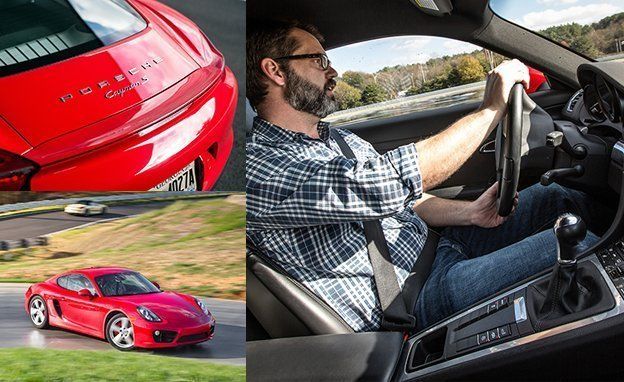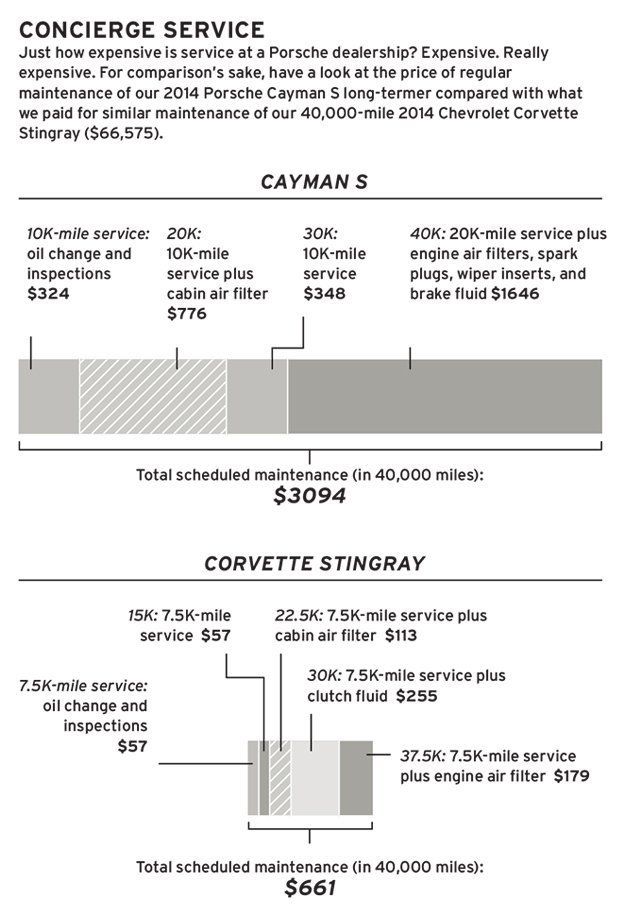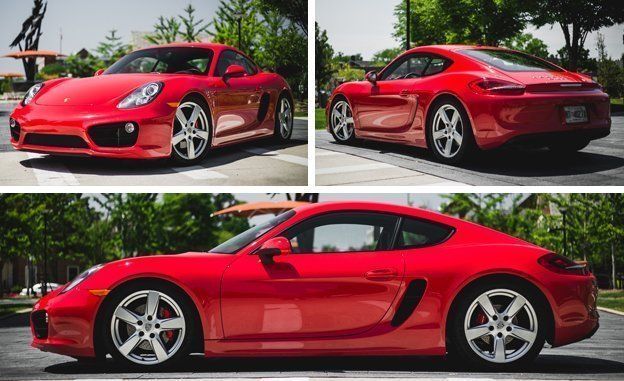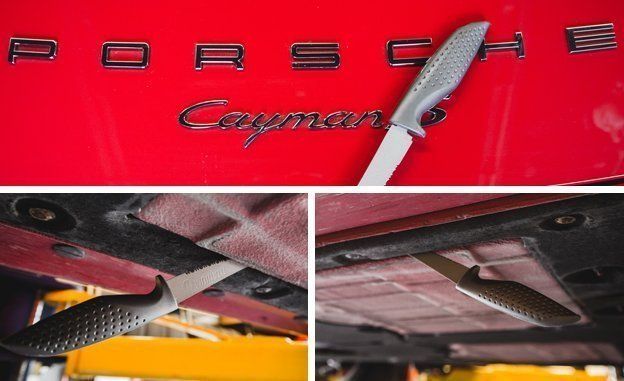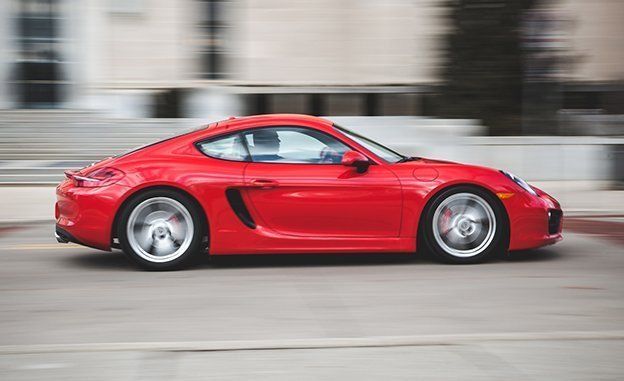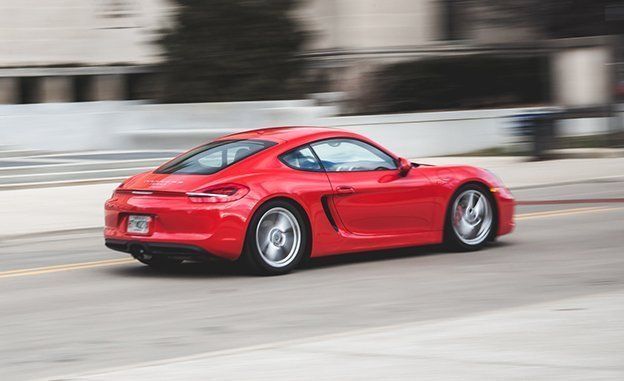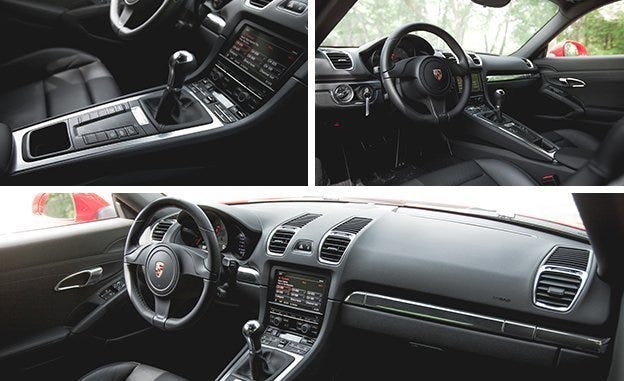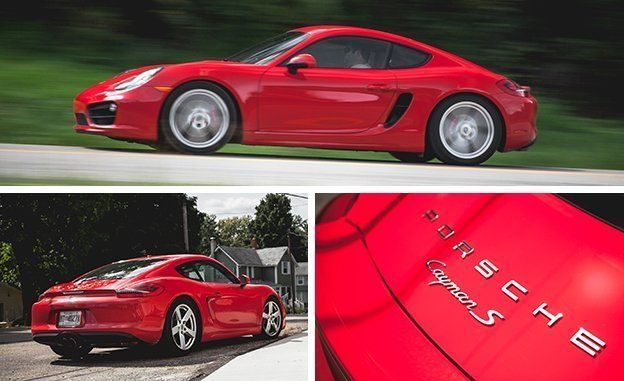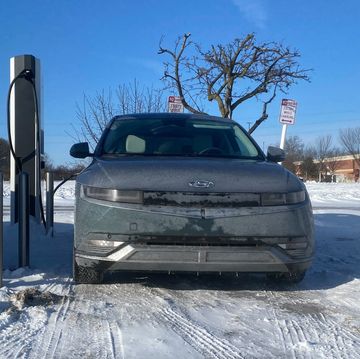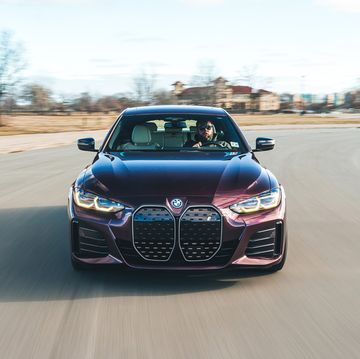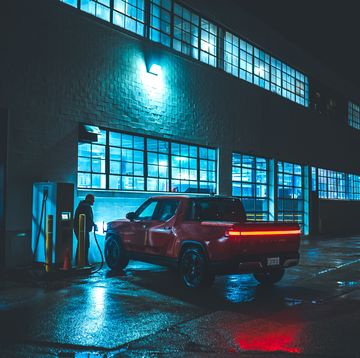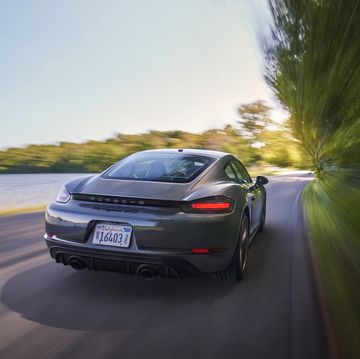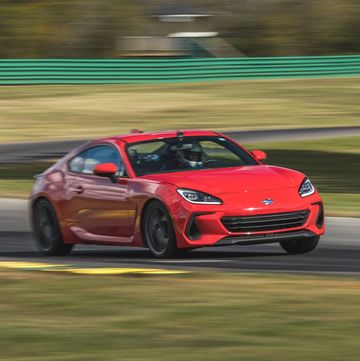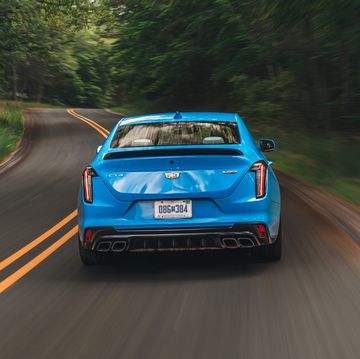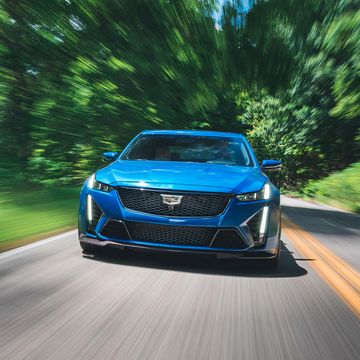I stood beside a Porsche public-relations man at the company’s Atlanta headquarters looking for the last time at our long-term Cayman S, determinedly not saying what I wanted to say, which was, “How much money would it take to make this my personal car?”
Even with 40,000 miles on its clock, I knew the Guards Red, lightly optioned Cayman S was out of my reach. Turns out, the PR guy was going through the same quiet calculations: “If the car started at 72 grand and I could get it for its auction price, then . . .” But the math didn’t work for him, either.
I had just driven the thing from the frigid north down to Porsche’s tiny bit of Germany in America as a sort of homecoming (and to goof around on the company’s little road course). It was like one of those Saturn homecomings in Spring Hill, Tennessee, more than a decade ago. But instead of mediocre economy cars and the people who felt inexplicably passionate about them, I was driving arguably the best all-around sports car on the market. My passion was justified, and I would be leaving without what I’d grown to think of as mine.
I arrived in Atlanta on the very day Porsche announced the Boxster and Cayman would get a new name (718) and confirmed what everyone already knew: That the model would lose, in about a year’s time, its gem of a naturally aspirated flat-six in favor of a new turbocharged flat-four. So integral to the appeal of the Cayman is its delicious exhaust and intake noise that the thought of it going silent—of not getting to experience it again in this particular car or in any future Cayman—was genuinely saddening.
That engine noise was the reason that, when we had optioned our long-termer 15 months before, we chose the $2825 sport-exhaust option to amplify the aural pleasure. This on a car we were desperately trying to keep to a reasonable sticker price. It’s a frivolous option only to those who have no ears.
Otherwise, we resisted the reams of splendiferous options Porsche offers for the Cayman S (and every other model it produces). We focused on performance-enhancing fare and ended up with a $72,545 Cayman S. That’s up $7750 on the base sticker of $64,795 for a 2014 model. While almost $8000 is not a small amount of money, it’s nothing compared with what’s on most Cayman Ss that we see, which regularly top $90K. Ours included Porsche Torque Vectoring ($1320), the nonadjustable Sport Suspension ($1235), the $800 partially power-adjustable sport seats, and the aforementioned Sport Exhaust System.
Throw in $670 for satellite radio and the $900 Convenience package, which included the totally necessary heated seats and the utterly pointless two-zone climate control, and we had a livable, focused sports car, even if we had no USB port, Bluetooth connectivity, or navigation system, and the cheapest-looking steering wheel we’ve ever seen in a modern Porsche. We also let stand the standard six-speed manual transmission (because we like to roll our own) and the standard 19-inch wheels (because we wanted to maintain some level of ride comfort). Had the GTS model been available at the time we ordered, we would have just opted for that, as it brings a large load of standard equipment for a moderately sized load of extra cash.
One of our staffers hated the standard five-spoke wheels; another wished we’d ordered the adjustable shocks; a few quibbled about the lack of connectivity; most complained at one point or another about the ugly steering wheel; and virtually everyone was amazed at how few creature comforts $72K buys in a modern Porsche. But one drive in the thing and all was forgiven. Its perfectly weighted hyper-accurate steering, smooth clutch takeup, certain shifter, linear power delivery, and neutral handling turned out to be more compelling than a USB socket. Go figure.
The notebook quickly filled with hosannas. “Perfect,” “a doll,” “delicious,” “splendid,” “fantastic,” “excellent.” We pretty much wore out the list of positive adjectives in the synonym section of dictionary.com. And we accumulated miles quickly thanks to the Cayman S’s surprisingly practical two-trunk scheme. This was one sports car that saw plenty of road-trip miles, including journeys to Virginia, Pennsylvania, and North Carolina, among other destinations in the eastern half of the U.S. Our final road trip to Atlanta was by way of the glorious roads of the Blue Ridge Mountains.
While we maintain that a Cayman S is more of a holistic sports car than a platform for delivering stunning performance numbers, the 325-hp 3025-pound Cayman S posted solid test-track figures. Once properly broken in, our car ran a 4.2-second zero-to-60-mph sprint and a 12.7-second quarter-mile time at 112 mph, both a few tenths of a second off the times of the 2014 Chevrolet Corvette Stingray that we also had in the fleet, but the Cayman’s engine never blew up, either. The Porsche circled the skidpad with a near neutral demeanor and 1.03 g’s worth of grip and stopped in a stunning 145 feet from 70 mph with zero fade. With 40,000 miles on it, the Cayman matched its earlier acceleration and cornering performance but added nine feet to its braking distance. Several laps of Porsche’s mini road course at its Atlanta HQ revealed that the Cayman S has lost none of its capabilities, grace, or hunger for fast driving. Our only complaint was with the Goodyear Eagle F1 tires. We suspect a different tire would have provided more progressive breakaway characteristics. But the Goodyears were the only summer tires available with the 19-inch wheel package for 2014.
Sports cars are not without their compromises, though. And here we’re not talking about this vehicle’s lack of creature comforts. We opted for the nonadjustable sport suspension in our Cayman S, which drops the car 0.8 inch compared with the already low-slung standard car. It sat there hugging the ground like a pretty red scarab. The downside, other than the occasional clumsy exit from the driver’s seat, was that we needed to approach even moderately steep driveways with the care normally reserved for bomb-squad operations. Our car’s chin bore the scars of the momentarily careless. Worse, someone managed to punch a dent in the underside of the body roughly the shape and size of the speed bumps in our office complex.
But the world was not done abusing the belly of our little beast. We found a titanium-bladed kitchen knife jammed, somehow, into the underside of our Cayman. The blade was lodged between two panels on the passenger’s side and was easily removed. The knife was either craftily inserted by a miscreant or was kicked up from the road in the most improbable way. Neither explanation makes much sense, frankly. But the only lasting damage was to our understanding of physics and/or our faith in humanity.
Otherwise, the Cayman S was a better real-world car than the Stingray with which it shared space in our long-term stable. A brutal, face-blisteringly cold winter presented no particular challenge. The Cayman S started quickly and ran flawlessly. It was even fun to drive in the white stuff while wearing its Michelin Pilot Alpin PA4 winter tires, assuming the snowdrifts weren’t too high.
This is not to say there were no problems. We had a vexing engine-oil-level issue. We added Mobil 1 three times in our first 16,000 miles at the behest of the oil-level sensor, which pops up the dire warning: “Oil level below min. Refill oil at once. Do not drive on.” It happened at 1881 miles, again at 7643 miles, and again at 15,774 miles. Then, intermittently, we started getting a warning about the oil level being “above maximum.” We drained about a quarter of a quart, even though the warning had already gone away. We took it to the dealer who said the oil level was still almost two quarts too high. We weren’t sure if the oil-level sensor was schizophrenic or if we were. But after 16,000 miles we had no further warnings and added no more oil. We suspect we’d gotten bum low-oil readings from the sensor and added oil when it wasn’t necessary. Most frustrating: This all probably could have been avoided if the Cayman had a dipstick, which it doesn’t.
At 17,785 miles, we took it to the dealership to replace, under warranty, a broken washer-fluid line. At 29,637 miles we returned to the dealership to investigate a rattling noise we began to hear coming from the steering column or dash. Turns out the culprit was a left-front-strut upper bearing and support, which the dealer replaced under warranty. By the end of its stay with us, the Cayman’s Cayman-shaped remote key fob locked and unlocked doors only intermittently. The dealer replaced it free of charge.
Other repairs included a new windshield to replace the rock-shattered original. That ran us $880. At 34,880 miles, the rear tires were riding on the wear bars and making a helluva racket. Those cost a total of $814 to buy and have mounted.
The only bills that seemed excessively high, though, were those for routine service. Simple oil changes and inspection visits cost us $324 at 10,000 miles (including $188 in labor costs) and $348 at 30,000 miles. At the 20,000-mile service, the dealer did the normal oil change and inspections but also included two engine air filters and a cabin air filter. That cost a staggering $776, $540 of which was the labor charge. The 40,000-mile service, which included an oil change, air-filter changes, cabin-air-filter change plus spark plugs, windshield-wiper inserts, and fresh brake fluid, cost $1646.
On the upside, we paid for nothing else but wear-and-tear items. So, y’know, maybe I could make the monthly nut on a used Guards Red Cayman S. It’s just money.
Rants and Raves
Erik Johnson: I need more flat-six noise in my life.
K.C. Colwell: The cup holders are located too far from the roll axis, so a tiny, one-degree disruption results in a coffee volcano.
Jeff Sabatini: The steering wheel is an abomination. The Sport Design wheel was only $250. We should have ordered that.
Eric Tingwall: The suspension is extremely taut, but the damping takes the bite out of every impact.
Don Sherman: Driver’s back pain starts after four hours in the saddle.
Alex Stoklosa: The base sound system isn’t bad. I had to check twice to make sure it wasn’t the sell-your-children Burmester setup.
K.C. Colwell: People may think this is a starter Porsche, but they are asshats. This is the real McCoy.
Jennifer Harrington: I wish it had an actual dipstick for the engine oil.
Carolyn Pavia-Rauchman: Well, that was fun.
Jared Gall: You can fit probably 10 bags of water-softener salt in the frunk.
Rusty Blackwell: The Cayman’s engine sound surely plays over the loudspeakers in heaven. At least, my heaven.
Eddie Alterman: Astounding body control and transitional behavior. Nothing else under $100K feels this natural.
Tony Quiroga: Drive it and all its faults are forgiven.
WHAT WE LIKE: What we like best is not its rousing engine note or its eagerness to turn or its excellent steering system or its near-perfect shifter. No, what we like best about our long-term Cayman S—now 75 percent of the way through its stay with us—is that a drive in it is an automotive palate cleanser. The Cayman S’s clarity of purpose and deliciously mechanical nature is the perfect salve for our enthusiast hearts after commuting in overwrought crossovers or whittling away hours of our lives in CVT-equipped econoboxes or driving any number of cars that, despite excellent performance, fail to connect with their drivers. Nothing that we’ve encountered in our 30,000 miles with the car has diminished the Cayman S’s place as our North Star of sports-car goodness. We have no proof of this, but we’re convinced that the word “love” has never appeared so many times in any of the logbooks of previous long-term cars. The most recent note in the book reads, “I wish this car’s odometer would stop working so that we might keep it forever.”
WHAT WE DON’T LIKE: Well, we definitely do not like cheap serrated kitchen knives with blades allegedly made of titanium. It’s not that we’re knife snobs, although we are. It’s that we found just such a hard-plastic-handled knife wedged between two underbody panels on the passenger side of our car. It did no damage to the car, only to our concept of physics. The blade was too long for some miscreant to insert it while the low-riding, sport-suspension Porsche was on the ground. And anyone who would intentionally stab the belly of such a beautiful thing while it was up on a lift is . . . well, whatever word means “worse than a miscreant.” We are, therefore, forced to assume that the knife was road debris, kicked up in precisely the correct alignment at precisely the right location. It’s impossible, but there it is. We removed the knife so as not to experience the unfortunate and also kind of hilarious fate of rally co-driver Timo Rautiainen. There is one staffer who finds the seat hurts her back on long trips. We’ve ordered her a new back. There are literally no other complaints. Oh, one staffer noted that with even just 200 pounds of water-softener salt in the frunk, you need to be very careful over bumps. So be mindful of that.
WHAT WENT WRONG: We are pleased to say that our Cayman S’s apparent excessive thirst for motor oil has passed. Now we only get a faint whiff of burned oil on occasion. But we’ve added no additional quarts since our last update. We had to replace the windshield after a large crack developed around 17,000 miles. That ran $879.97. One of the windshield-washer feed lines was replaced under warranty at 17,785 miles. The Cayman S was treated to its 20,000-mile service, which included a series of checks, fresh oil and a new oil filter, and new air and cabin-air filters. That cost us a not-insubstantial $776.06. At 29,642 miles, we took the Cayman S back to our dealer to check on a front-end rattle we were hearing when we went over bumps. Replacing the left-front strut upper bearing and support (under warranty) solved the problem. At the same time we paid for a $330.19 oil change.
WHERE WE WENT: The Cayman S, with its dual cargo holds, proves to be an excellent road-trip car, assuming you are satisfied bringing along only one other person. Since we last updated you on the car, it made the pilgrimage to Virginia International Raceway for our annual Lightning Lap testing (we did not run it on the track). It’s also made a couple of trips to southern Indiana and a second jaunt to Virginia, this time for family-related travel.
Months in Fleet: 12 months Current Mileage: 33,096 miles
Average Fuel Economy: 23 mpg Fuel Tank Size: 16.9 gal Fuel Range: 390 miles
Service: $1448.67 Normal Wear: $0 Repair: $0
Damage and Destruction: $929.97
WHAT WE LIKE: We like very nearly everything about this car. Of special note are the thrilling exhaust; the perfectly weighted shifter action; the telepathic steering response; and the remarkable cargo space, split between the front and rear trunks. We tried to keep the cost of this car down and order a pure version of Porsche’s best sports car. That meant no navigation system, no unnecessarily large wheels, and no mega-expensive 18-way power seats. And while we might like a USB port to play our music through the half-decent stereo system and we might think the steering-wheel trim looks cheap, we remind ourselves during those moments that we have become soft and silly and really must stop whining right away. Then everything is perfect.
WHAT WE DON’T LIKE: Since taking delivery of our Cayman S in August of last year, our distaste for speed bumps and steep driveway aprons has increased exponentially. The optional sport suspension drops the already low-slung Cayman an additional 0.8 inch, meaning that drivers who are careless for even a moment will be subjected to a scraping sound so teeth-clenchingly, eye-squintingly, gut-wrenchingly awful that a reasonable person would never be careless again. With anything. The thing we really don’t like and can’t do a damn thing about, though, is the Cayman’s lack of a dipstick. Like many current cars (especially German ones, it seems), the Cayman uses a sensor to tell you when you’re running low on oil or when you or the stoned dude at the oil-change emporium has overfilled your engine. Call us Luddites if you’d want, but we like to actually, physically check the oil. See below for why.
WHAT WENT WRONG: We’re currently wondering if our oil-level sensor is a little, you know, nuts. Our dealer is—so far—unconcerned. We’ve added oil three times in our first 16,000 miles. At 1881 miles, we added a quart of Mobil 1 after getting an “Oil level below min. Refill oil at once. Do not drive on” warning message. At 7643 miles, we instructed the car to run a check of the oil level and it came up low so we added a quart and half. The dire warning popped up again at 15,774 miles. We added yet another 1.5 quarts of Mobil’s good stuff (about $10/quart at our auto-parts store). Then, intermittently, we started getting a warning about the oil level being “above maximum.” We drained about a quarter of a quart, even though the warning had already gone away. Flummoxed, we soon took it to the dealer, who said the engine oil was a quart and a half high. The math is not really working out here. So, now that we’re certain we have exactly the right amount of oil in the sweet little engine, we will watch for any warning lights. If we get another, we’ll take the thing back to the dealer to make sure the sensor isn’t faulty. According to the dealer tech (and the Porsche maintenance PDF he printed out for us), Porsche considers an oil-consumption rate of up to 1.6 quarts per 622 miles to be at the upper end of the acceptable range. That seems a staggeringly high rate to us, and the owner’s manual in our car says only that, “It is normal for your engine to consume oil.” Considering we were adding oil at a rate at about 1.6 quarts every 6000 miles, we’re apparently doing just fine. We’ll keep our eyes on the sensor.
WHERE WE WENT: We’ve visited, in rough chronological order, the states of Indiana, West Virginia, Virginia, Maryland, Pennsylvania, North Carolina, Illinois, Ohio, and Kentucky in our first 16,000 miles with our lovely little gator.
Months in Fleet: 5 months Current Mileage: 16,337 miles
Average Fuel Economy: 22 mpg Fuel Tank Size: 16.9 gal Fuel Range: 370 miles
Service: $324.16 Normal Wear: $0 Repair: $0
Damage and Destruction: $96.23
Over the last few years, it has become something of a Car and Driver pastime to complain about, scoff at, and, in every way, ridicule the totally absurd cost of optional equipment on Porsche vehicles. We might feel bad about this, were it not for the fact that we sometimes get Porsches in here for tests that are so larded up with insane—and insanely priced—options that their as-tested bottom lines are double their base prices. Double.
Now, the company typically points out (with an inevitable sigh) that the relatively low level of equipment offered on base Porsches and the plethora of standalone options allow buyers to tailor their car to perfectly meet their desires. And that’s not untrue. We get it.
So when Porsche offered us a Cayman S to run through our 40,000-mile gantlet, we were faced with the same dilemma as buyers. Could we actually configure a Cayman S that stayed out of the $90,000-plus range? We did pretty well, if we do say so ourselves. Our Cayman S stickers for a not-totally-unreasonable $72,545. That’s up $7750 from the base MSRP of $64,795. By Porsche standards, that’s a pittance. And better yet, the car is no hair shirt. It is, in fact, spectacular. So much so that we’ve accumulated nearly 11,000 miles on our little gator before our not-totally-lazy staffer managed to write this long-term-car introduction. But we needn’t dwell on his shortcomings. Let’s look instead at our Cayman’s specifics.
We chose to have it slathered in no-cost Guards Red. Yes, Guards Red is something of a cliché and it doesn’t follow the current fashion in the way that, say, Mahogany Metallic might. But we’re looking out our window at the car this very moment and we can tell you that there is nothing at all wrong with a Guards Red Cayman S. Also, Guards Red is one of only four hues that don’t cost any extra money (the others are black, white, and Racing Yellow). We stuck with the standard 19-inch wheels because, really, do you need 20s on a Cayman? Nope. We chose the six-speed manual because it doesn’t cost anything and also it’s entirely awesome. The items we paid extra for were pretty much all to make the car perform better. So we opted for the $1320 Porsche Torque Vectoring, the $1235 nonadjustable Sport Suspension, and the $2825 Sport Exhaust System. Okay, that last one doesn’t make the car perform any better, unless you consider a stirring aural experience to be part of the performance package. Our ears say it is, and we always listen to our ears.
Because we are not totally immune to the charms of luxury and convenience, we opted for the $670 satellite-radio receiver and the $900 Convenience package. That latter option brings two-zone automatic climate control, about which we don’t really care. But it also brings heated seats, about which we Michiganders care greatly. Butt-warmers are especially important to those, like us, who plan to drive their Porsche all winter long.
Speaking of winter, we mounted a set of Michelin Pilot Alpin winter tires to our standard rims in November, replacing the Goodyears that came on the car. We managed about 10,000 miles on the Goodyear Eagle F1 Asymmetric 2 summer tires before the swap, averaging 2500 miles per month. And considering that we visited Indiana, West Virginia, Virginia, Maryland, Pennsylvania, North Carolina, Illinois, and Ohio in the car’s first four months with us, there is apparently no trepidation about taking this two-seat sports car on road trips. We’ve logged no complaints about the car’s ride, despite the buffed suspension settings. And the convenience of the two luggage compartments still manages to surprise many editors.
What does not surprise them is the near-perfect steering. The excellent brakes. The delicious flat-six soundtrack. The boffo shifter. Good God, this car is good. Oh, you want some data to back up those impressions? Well, in our initial testing, the 3025-pound, 325-hp Cayman S accelerated to 60 mph in 4.2 seconds and through the quarter-mile in 12.7 seconds at 112 mph. That’s only a tenth of a second less-quick than the last PDK-equipped Cayman S we tested. It’s three-tenths slower than our 460-hp long-term Corvette Stingray. Our long-term Cayman S also stopped from 70 mph in a scant 145 feet. And it gripped the skidpad at 1.03 g.
Okay, so long trips have a few of our staffers complaining of backaches, and if we had it to do again, we would have ordered the GTS version of the car, which brings a ton more equipment for not a ton more money. But that version wasn’t available when we ordered our car. Predictably, staff commenters, while all claiming allegiance to our cost-conscious approach to spec’ing this car, would each like to change a few things. One wants the $250 SportDesign steering wheel with its shiny loveliness to replace our dour, black unadorned spokes. The same guy doesn’t like the standard wheels because, well, he just doesn’t. He would pay to have them painted black for $880 and upsized for between $1560 and $2990. Further, he would like to add the $185 color-painted crests for the wheels’ center caps. Another staffer would spring for the extra $555 over the price of the sport suspension to get the PASM adjustable shocks. We would all like a USB port for charging our devices and/or audio playback.
Possibly, you see where this is headed. If we listened to every staffer over the course of the loan, we’d end up with a $90K Cayman S. And then we would complain about its price.
Months in Fleet: 4 months Current Mileage: 10,655 miles
Average Fuel Economy: 23 mpg Fuel Tank Size: 16.9 gal Fuel Range: 390 miles
Service: $324.16 Normal Wear: $0 Repair: $0
Specifications
Daniel Pund was named Road & Track's editor-in-chief in 2024 after helping to re-invent the venerable magazine brand as executive editor. For around 30 years, Pund has toiled away as a feature writer, car reviewer, editor, and columnist for every car magazine that matters (including Car and Driver and Autoweek) and a few that didn’t. He’s also contributed to Esquire and GQ and other general-interest publications.
